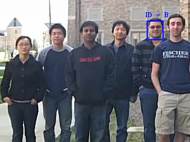Questionable Observer Detector spots repetitive crime scene observers
 If you are fond of crime solving TV series or movies, you probably heard that criminals always return to the scene of the crime. Led by that theory, a team of biometrics experts from the University of Notre Dame is developing a crime-fighting tool that can help law enforcement officials identify individuals who are found as observers at different crime scenes.
If you are fond of crime solving TV series or movies, you probably heard that criminals always return to the scene of the crime. Led by that theory, a team of biometrics experts from the University of Notre Dame is developing a crime-fighting tool that can help law enforcement officials identify individuals who are found as observers at different crime scenes.
Facial recognition systems found application in various areas with need for increased security, as well as in identification of wanted criminals. Law enforcement officials believe that perpetrators of certain crimes (most notably arson) do tend to witness their handiwork, and U.S. military in the Middle East believe that improvised explosive device (IED) bomb makers return to see the results of their work in order to evolve their designs.
Kevin Bowyer and Patrick Flynn of Notre Dame’s Department of Computer Science and Engineering, who have been researching the feasibility of image-based biometrics since 2001, join forces with Jeremiah Barr, a doctoral student in computer science and engineering, to develop a Questionable Observer Detector (QuOD) to identify individuals who repeatedly appear in video taken of bystanders at crime scenes.
The challenge was especially daunting because the researchers lacked a data base against which to compare faces. In order to overcome that problem, the University of Notre Dame team focused on an automatic facial recognition tool that didn’t need to match people against an existing database of known identities.
Instead, the algorithm creates “face tracks” (merged face image sequences) for all individuals appearing in a video and compares them to determine if any faces from different video clips look similar enough to match each other.
When the technology spots a match, it adds it to a group of video appearances featuring just that person. In this way, it attempts to cluster together the pieces of different video clips that represent the same person. An individual is considered suspicious if he or she appears too frequently in the set of videos.
However, there are a few drawbacks which need to be solved. Optimum facial recognition technology requires high quality lighting and video resolution, which is often unavailable at crime scenes. Breakthroughs in image manipulation and recording technologies could solve those problems, however, there are other problems such as the fact that observers aren’t directly facing the camera or they might wear a disguise.
The researchers are continuing the improvement of their system and they are confident that these challenges can be solved. Since the tool helps the officials to identify individuals by their actual presence at multiple crime scenes rather than by suspicion, the researchers believe their system won’t cause civil liberties concerns since there is positive social benefit involved.









Leave your response!